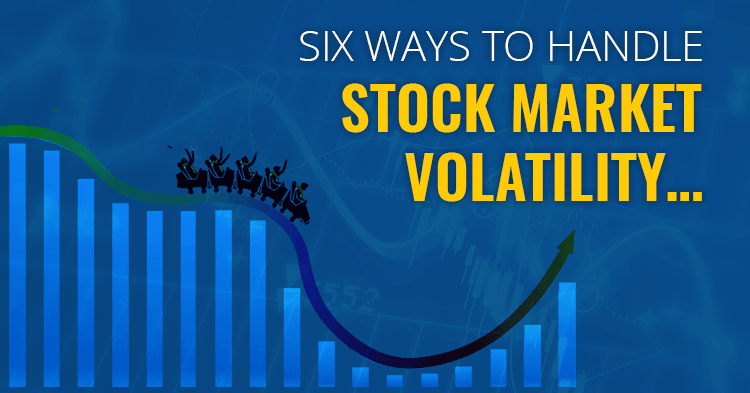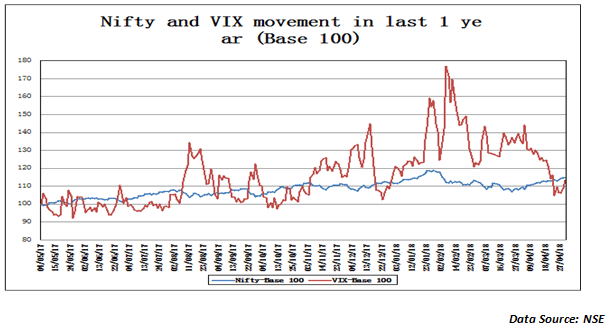
What do we understand by market volatility? From a general perspective, volatility refers to the ups and downs of the Nifty or the Sensex. But, volatility also has a technical meaning and it means the extent to which the stock deviates from the average. Greater the deviation, greater is the volatility of the stock. Why is volatility so important for stocks and indices? That is because volatility implies risk. Consider the chart below…

The chart above captures how the Nifty moved vis-à-vis the Volatility Index (VIX). The VIX is calculated by the NSE and it is called the Fear Index. But what is more important here is that over a period of time, the Nifty has moved inversely with the VIX. What that logically implies is that higher risk implies lower returns on the Nifty and vice-versa. Even over a longer time frame of 5-8 years this relationship appears to hold. So the best way to handle volatility will be to manage the risk rather than trying to enhance the returns. Here are 6 ways to handle the volatility.
When you make your financial plan that is directed towards your long term goals, the focus should be on managing all kinds of market situations and risks. Your long term plan typically has certain in-built checks like regular investing, asset allocation and rebalancing to take care of these basic issues pertaining to market volatility. When you say that your equity funds will create wealth over a period of 10-15 years, you are obviously factoring in all these possibilities into your calculation. Just because the equity markets become volatile, you do not have to take a call to exit equities. Maintain your discipline with respect to your long term goals.
When the markets are too volatile then rule-based allocation works best for you. What does that mean? Firstly, set a rule for you to shift out of asset classes. For example, if the P/E of the Nifty crosses 23X, then you can set a rule to automatically reduce your exposure to equity and transfer to debt. Similarly, if the interest rates have touched a 10-year low then your focus should be to tactically shift out of bond funds (specifically long duration bond funds) and either shift to variable rate funds or into equities. Here you do not have to take a view on the market and worry about whether you will be right or wrong. If you set broad rules in your asset allocation based on past experience, you are good to handle volatility in the markets.
What is the right level to buy stocks? In a volatile market, this question really does not add much value. That is because it is practically impossible to catch the bottoms and the top of the market consistently. It is not only impractical but also does not add much value. On the contrary, if you adopted a phased approach to investing, then your purpose will be better served. The rupee cost averaging (RCA) that your phased approach will give you will automatically make you eligible to get the best price when you are buying. In the long run, this will reduce your average cost of borrowing and will help you enhance your returns. This is a good passive method of handling volatility.
You may have noticed that gold prices normally tend to go up when there is global turmoil, threat of war or even when there is a financial crisis. Similarly, gold prices also tend to do well when equity market volatility goes above a certain level. Your standard allocation to gold in your portfolio should be in the range of 7-10%. During times of volatility, you can look to increasing your allocation to gold to better protect your portfolio value.
You can either call this a defensive approach or a quality approach. Why does a stock like Hindustan Unilever or Britannia not lose much value in a market correction? That is because they are less vulnerable to the volatility in the market. They have robust business models, perpetual demand for their products and have created brands that hold them in good stead in bad times. It would be a bad idea to be over exposed to mid-caps and small caps in volatile markets as they could be the worst impacted. Also, the stories that created the rally could be more vulnerable. Position accordingly.
This may sound paradoxical but quite often the best decision in volatile markets may be to do absolutely nothing. In fact, the worst thing to do will be to try and churn your portfolio aggressively to make the best of volatility. In the end, you will end up with too much of costs, tax implications and little by way of return. Trying to outguess volatile markets is never a great idea and you are unlikely to be too successful in that effort. Staying quiet may be a good strategy.
Volatility is a part and parcel of market. In markets, we also know is at risk. Risk has to be managed passively rather than trying to do it actively. More often than not, a calculated goal-based approach to your investments will work best.
Published on: May 3, 2018, 12:00 AM IST
We're Live on WhatsApp! Join our channel for market insights & updates